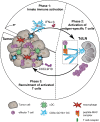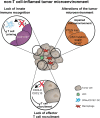Mechanisms of tumor escape in the context of the T-cell-inflamed and the non-T-cell-inflamed tumor microenvironment
- PMID: 26989092
- PMCID: PMC4986232
- DOI: 10.1093/intimm/dxw014
Mechanisms of tumor escape in the context of the T-cell-inflamed and the non-T-cell-inflamed tumor microenvironment
Abstract
Checkpoint blockade therapy has been proven to be highly active across many cancer types but emerging evidence indicates that the therapeutic benefit is limited to a subset of patients in each cancer entity. The presence of CD8(+) T cells within the tumor microenvironment or the invasive margin of the tumor, as well as the up-regulation of PD-L1, have emerged to be the most predictive biomarkers for clinical benefit in response to checkpoint inhibition. Although the up-regulation of immune inhibitory mechanisms is one mechanism of immune escape, commonly used by T-cell-inflamed tumors, exclusion of an anti-tumor specific T-cell infiltrate displays another even more potent mechanism of immune escape. This review will contrast the mechanisms of immunogenic, T-cell-inflamed, and the novel concept of non-immunogenic, non-T-cell-inflamed, adaptive immune escape.
Keywords: checkpoint blockade; immune evasion; immunotherapy; oncogenes.
© The Japanese Society for Immunology. 2016. All rights reserved. For permissions, please e-mail: journals.permissions@oup.com.
Figures



References
Publication types
MeSH terms
Grants and funding
LinkOut - more resources
Full Text Sources
Other Literature Sources
Research Materials

